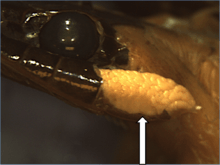Duvernoy's gland
The Duvernoy's gland is a gland found in some groups of colubrid snakes. It is distinguished from the venom gland and is not found in viperids or elapids. It was named for French zoologist Georges Louis Duvernoy who first described the gland in 1832.[1]

The Duvernoy's gland is positioned posterior to the eye, encased in a thin cover of connective tissue, and consists mostly of serous cells. A single, short duct extends anteromedially from the lumen of the gland to the base of the posterior fangs.
Function
The function of the Duvernoy's gland has been the source of much study and speculation, and debate is still ongoing. It is widely recognized that the Duvernoy's gland is the homologue of venom glands in vipers and elapids.[2][3] However, the two types of glands are also “anatomically and functionally distinct,” leading experts such as Dr. Kenneth Kardong to maintain the distinction between the Duvernoy's gland and venom glands.[2][4] Other scientists such as Dr. Bryan Fry maintain that the Duvernoy gland is a primitive version of a venom gland and should be referred to as such.[3] Dr. Stephen Mackessy suggests Duvernoy's gland does secrete venom and is homologous to the venom gland found in front-fanged snakes.[5]
Because the secretions of this gland are associated with the swallowing behavior of snakes, the Duvernoy's gland may play a role in swallowing and/or digestion.[6] Kardong also notes that although some Duvernoy's gland secretions may be toxic and that they can produce pain, swelling, and other effects if injected subcutaneously; this does not make those secretions venoms.[6][7]
Evolution
The evolutionary path of these separate glands may come from “venom proteins” whose genes are widely expressed in tissues of both venomous and non-venomous snakes. These genes are over-expressed in the venom glands (including Duvernoy's gland), indicating the secretions from these glands evolved separately, rather than sequentially.[5]
References
- Duvernoy (1832). "Mémoire sur les caractères tirés de l'anatomie pour distinguer les serpents venimeux des serpents non venimeux". Annales des Sciences Naturelles. 26: 113–160.
- Kardong, Kenneth V. (2002). "Colubrid snakes and Duvernoy's "venom" glands" (PDF). Toxin Reviews. 21 (1): 1–15. doi:10.1081/txr-120004739.
- Fry, Bryan G.; Wüster, W.; Ramjan, Sheik Fadil Ryan; Jackson, Timothy; Martelli, Paolo; Kin, R. Manjunatha (2003). "LC/MS (liquid chromatography, mass spectrometry) analysis of Colubroidea snake venoms: evolutionary and toxinological implications" (PDF). Rapid Communications in Mass Spectrometry. 17: 2047–2062. doi:10.1002/rcm.1148.
- Kardong, Kenneth V. (March 1996). "Snake toxins and venoms: an evolutionary perspective" (PDF). Herpetologica. 52 (1): 36–46.
- Mackessy, Stephen P.; Saviola, Anthony J. (2016-11-01). "Understanding Biological Roles of Venoms Among the Caenophidia: The Importance of Rear-Fanged Snakes". Integrative and Comparative Biology. 56 (5): 1004–1021. doi:10.1093/icb/icw110. ISSN 1557-7023. PMID 27639275.
- Kardong, Kenneth V. (1982). "The evolution of the venom apparatus in snakes from colubrids to viperids and elapids" (PDF). Mem. Inst. Butantan. 46: 105–118.
- The word "toxic" describes the properties of the substance whereas the word "venom" implies its biological use for the organism.